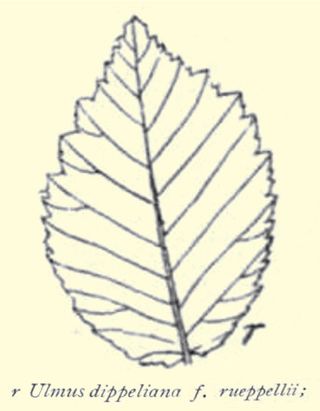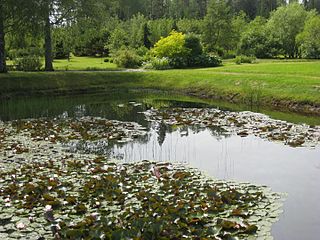
Witch-hazels or witch hazels (Hamamelis) are a genus of flowering plants in the family Hamamelidaceae, with three species in North America, and one each in Japan (H. japonica) and China (H. mollis). The North American species are occasionally called winterbloom.

An arboretum is a botanical collection composed exclusively of trees and shrubs of a variety of species. Originally mostly created as a section in a larger garden or park for specimens of mostly non-local species, many modern arboreta are in botanical gardens as living collections of woody plants and are intended at least in part for scientific study.

The Polly Hill Arboretum includes 8 ha under cultivation, with an additional 16 ha of native woodland, located on Martha's Vineyard at 809 State Road, West Tisbury, Massachusetts, United States. It has been developed since 1958 by the horticulturist Polly Hill, and was listed on the National Register of Historic Places in 2015.

The Connecticut College Arboretum is a 300 ha arboretum and botanical gardens, founded in 1931, and located on the campus of Connecticut College and in the towns of New London and Waterford, Connecticut, United States.

The Holden Arboretum, in Kirtland, Ohio, is one of the largest arboreta and botanical gardens in the United States, with more than 3,600 acres (1,500 ha), including 600 acres (240 ha) devoted to collections and gardens. Diverse natural areas and ecologically sensitive habitats make up the rest of the holdings. Holden's collections includes 9,400 different kinds of woody plants, representing 79 plant families.

The Dawes Arboretum is a nonprofit arboretum located in Newark, Ohio. It includes nearly 2,000 acres (8 km2) of plant collections, gardens and natural areas. The site includes approximately 12 miles (19 km) of hiking trails and roadways for a four-mile (6 km) driving tour.
A plantsman is an enthusiastic and knowledgeable gardener, nurseryman or nurserywoman. "Plantsman" can refer to a male or female person, though the terms plantswoman, or even plantsperson, are sometimes used. The word is sometimes said to be synonymous with "botanist" or "horticulturist", but that would indicate a professional involvement, whereas "plantsman" reflects an attitude to plants. A horticulturist may be a plantsman, but a plantsman is not necessarily a horticulturist.

Bailey Arboretum is a 42-acre (17 ha) arboretum located in Lattingtown, New York, a small village on the North Shore of Long Island. It opened to the public on Aug. 5, 1969 after being donated to Nassau County in 1968 by the heirs of Mr. and Mrs. Frank Bailey. Through an agreement with the Village of Lattingtown, admission to the arboretum was limited to 200 people at any one time.

Hoyt Arboretum is a public park in Portland, Oregon, which is part of the complex of parks collectively known as Washington Park. The 189-acre (76 ha) arboretum is located atop a ridge in the Tualatin Mountains two miles (3.2 km) west of downtown Portland. Hoyt has 12 miles of hiking trails, two miles of accessible paved trails, and is open free to the public all year. About 350,000 visitors per year visit the arboretum.

Nichols Arboretum, locally known as the Arb, is an arboretum on the campus of the University of Michigan, in Ann Arbor, Michigan. The Arb is located adjacent to the Huron River, and features over 400 species, including 110 species of trees, in a varied, hilly landscape. A signature feature of Nichols Arboretum is the W. E. Upjohn Peony Garden, which features the largest collection of heirloom peonies in North America.

The Sir Harold Hillier Gardens is an arboretum comprising 72 hectares accommodating over 42,000 trees and shrubs in about 12,000 taxa, notably a collection of oaks, camellia, magnolia and rhododendron.

The Morris Arboretum & Gardens of the University of Pennsylvania is the official arboretum of the Commonwealth of Pennsylvania. The Arboretum is open daily except for major holidays. It is located at 100 East Northwestern Avenue, Chestnut Hill, Philadelphia, Pennsylvania.

The hybrid elm cultivar Ulmus × hollandica 'Dampieri', one of a number of cultivars arising from the crossing of the Wych Elm U. glabra with a variety of Field Elm U. minor, is believed to have originated in continental Europe. It was marketed in Wetteren, Belgium, in 1851 as 'Orme de Dampier', then in the Low Countries in 1853, and later identified as Ulmus campestris var. nuda subvar. fastigiata DampieriHort., Vilv. by Wesmael (1862).

The Wych Elm cultivar Ulmus glabra 'Cornuta', in cultivation before 1845 – Fontaine (1968) gives its provenance as France, 1835 – is a little-known tree, finally identified as a cultivar of U. glabra by Boom in Nederlandse Dendrologie 1: 157, 1959.

Ulmus minor 'Rueppellii' is a Field Elm cultivar said to have been introduced to Europe from Tashkent by the Späth nursery, Berlin. Noted in 1881 as a 'new elm', it was listed in Späth Catalogue 73, p. 124, 1888–89, and in subsequent catalogues, as Ulmus campestris Rueppelli, and later by Krüssmann as a cultivar.
The elm cultivar Ulmus 'Folia Rubra' was listed as Ulmus campestris foliis rubris by Louis de Smet in his catalogue of 1877, and Edouard Pynaert van Geert in the same year who obtained the tree from M. Gaujard of Wetteren, Belgium. An U. campestris fol. rubrisHort. was distributed by the Späth nursery, Berlin, in the 1890s and early 1900s.

Emmenopterys henryi is a species of flowering plant in the family Rubiaceae. It is found in the temperate parts of central and southern China and in Vietnam. It is a deciduous tree with opposite leaves and can attain heights of 45 m and grow to be 1000 years old. The epithet is named after the Irish botanist and sinologist Augustine Henry. The trees may not flower until they are 30–100 years old, and flowering seems to be triggered by a long hot summer. Many inflorescences are accompanied by a large white bract.

The Elm cultivar Ulmus 'Myrtifolia Purpurea', the Purple Myrtle-leaved Elm, was first mentioned by Louis de Smet of Ghent (1877) as Ulmus myrtifolia purpurea. An U. campestris myrtifolia purpureaHort. was distributed by Louis van Houtte in the 1880s, by the Späth nursery, Berlin, in the 1890s and early 1900s, and by the Hesse Nursery, Weener, Germany, till the 1930s.

Kalsnava Arboretum is an arboretum in Kalsnava Parish, Madona Municipality, Latvia.

Jelena de Belder-Kovačič was a Slovenian-Belgian botanist and horticulturist, who worked extensively on the taxonomy and preservation of plant specimens, gaining an international reputation for her development of the Kalmthout and Hemelrijk Arboreta. Several varieties of plants she cultivated were recognized with awards from the Royal Horticultural Society in London and she was elevated to Baroness by Albert II of Belgium for her contributions to dendrology.



















